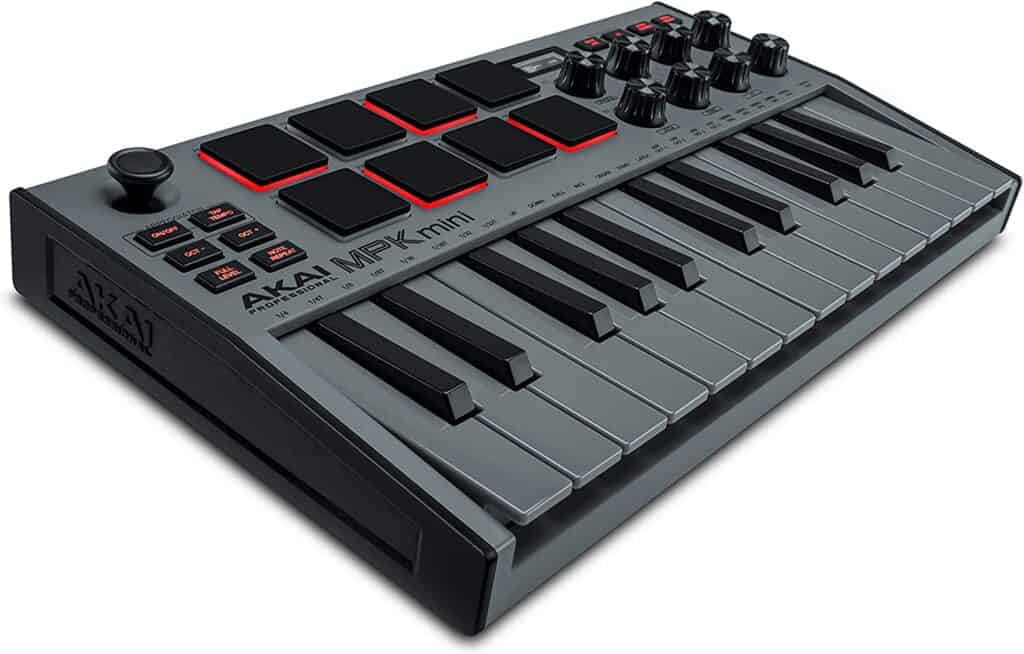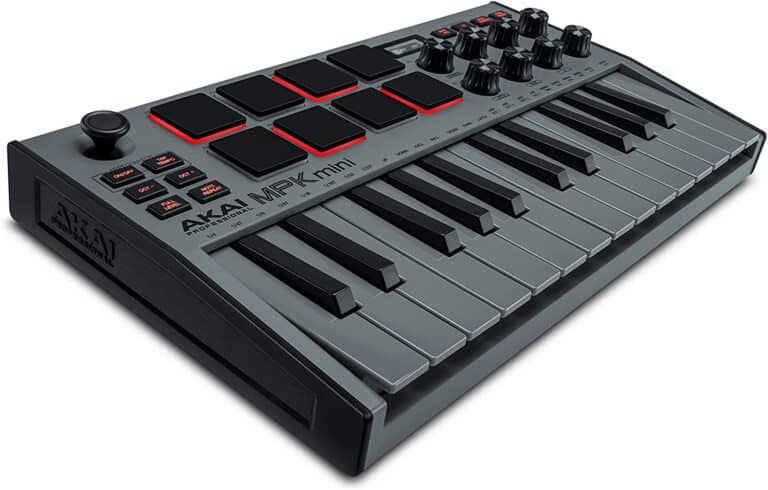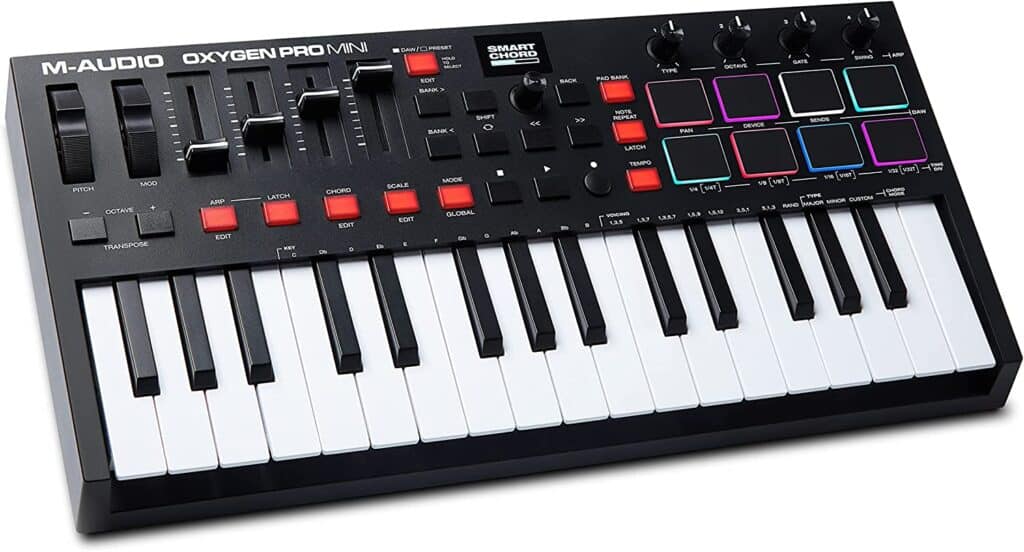BEST ALL-AROUND MIDI KEYBOARD
Akai Professional MPK Mini Mk3
This is probably the best beginner keyboard you can buy. It’s got a little bit of everything. Some drum pads, some controls, a keyboard, knobs, and faders.
BEST MIDI KEYBOARD FOR MORE KEYS
midiplus X4 mini MIDI keyboard
This is my favorite MIDI keyboard of all time. It’s got a slim, lightweight footprint on my desk with 49 glorious keys (4 octaves), and the build quality is insane.
A MIDI keyboard is one of the most useful and essential tools in modern music production and composition.
A great MIDI keyboard coupled with a DAW is really all you need to make incredible music. But how do you choose the best MIDI keyboard for your particular needs?
In this post, we’ll go over:
- What exactly is a MIDI keyboard
- The various features to look out for when shopping for a MIDI keyboard
- The best MIDI keyboards for every budget, use case, and production style
Let’s jump in!
Note: some of these links are affiliate links. Should you choose to purchase the products via these links, Composer Code will receive a small commission at no extra cost to you.
What is a MIDI keyboard?
A MIDI keyboard is a physical controller that sends MIDI data to a DAW (Digital Audio Workstation) or other compatible music software.
MIDI stands for Musical Instrument Digital Interface and is a protocol that allows electronic musical instruments and computers to communicate with each other.
A MIDI keyboard doesn’t make any sound on its own – it needs to be connected to a computer or other device in order to produce sound.
The data that a MIDI keyboard sends can be used to control just about anything in your DAW – from note information to virtual instrument parameters.
This makes MIDI keyboard controllers incredibly powerful and versatile tools for modern music production.
For example, you could use a MIDI keyboard to play a virtual piano sound within your DAW, trigger drum sounds, or adjust certain parameters like modulation and pitch.
MIDI keyboards come in all different shapes and sizes. Some are very simple and basic, while others are feature-packed with tons of buttons, faders, and knobs.
The type of MIDI keyboard you need will depend on your particular needs and production style. Let’s go over some of the main features to look out for when shopping for a MIDI keyboard.
What to consider when shopping for a MIDI keyboard
Probably the most important thing to consider when buying a MIDI keyboard is how many keys the keyboard has.
The vast majority of MIDI keyboards on the market have either 25, 49, 61, or 88 keys.
The number of keys you need will depend on what type of music you want to produce and how much space you have on your desk.
If you’re mostly producing electronic music, then you can probably get away with a 25 or 49-key keyboard. These keyboards are small and portable, making them great for traveling producers.
If you’re producing piano-based music or if you want the most realistic feeling possible, then you’ll want an 88-key keyboard. These keyboards are larger and heavier, but they offer the best playability.
I have used keyboards with a wide variety of key numbers, and I’ve settled on the 49-key format as the perfect blend between a smaller desktop footprint and enough octaves to not feel stifling.
The next thing to consider is the type of keybed that the MIDI keyboard has. The keybed is the part of the keyboard that you actually play the keys on.
There are two main types of keybeds: synth-action and weighted.
A synth-action keybed is what you’ll find on most lower-priced MIDI keyboards. These keybeds are designed to mimic the feel of an old-school analog synthesizer.
The keys on a synth-action keybed are very light and springy, making them easy to play but not as realistic feeling as a weighted keybed.
A weighted keybed is what you’ll find on more expensive MIDI keyboards. These keybeds are designed to mimic the feel of an acoustic piano.
The keys on a weighted keybed are heavier and have a more realistic feel. This makes them great for playing piano-based music, but they can be more difficult to play if you’re not used to the feel.
I personally prefer a synth-action keybed because I find it to be more comfortable to play, but it really comes down to your preference.
Some MIDI keyboards come with drum pads that can be used to trigger drum sounds or other samples.
Drum pads are a great way to add another dimension to your music production, and they provide a more visceral way of beat production than programming in MIDI notes.
If you’re interested in using drum pads, then look for a MIDI keyboard that has at least 8 pads.
Many MIDI keyboards with drum pads also have assignable controls like faders and knobs, which can be used to control things like volume, pitch, and modulation.
Some MIDI keyboards come with extra controls like faders, knobs, and buttons. These extra controls can be used to control just about anything in your DAW, from volume and panning to effects and instrument parameters.
The number and type of extra controls will vary from keyboard to keyboard, so it’s important to decide what you want to use the controls for before making a purchase.
Using knobs, faders, and buttons to control elements of your DAW can speed up your workflow by reducing mouse movements and keystrokes.
Many MIDI controllers also feature transport controls that let you stop, rewind, and play your DAW without having to use your computer keyboard.
From personal experience, this is super handy when you’re trying to navigate your session or nail down a part.
The last thing to consider is the type of connectivity that the MIDI keyboard has.
MIDI keyboards connect to your computer via USB, MIDI, or wireless.
USB is the most common type of connectivity, and it’s what you’ll find on most MIDI keyboards. USB is easy to use and provides a simple way to connect your MIDI keyboard to your computer.
MIDI is a more advanced type of connectivity that allows you to connect multiple MIDI devices to each other. If you’re planning on using multiple MIDI devices, then you’ll need a MIDI interface.
I’ve never needed a MIDI interface myself, and the USB connection present on most keyboards has worked just fine for me.
All MIDI keyboards will be compatible with all DAWs, but some come with special built-in DAW automation for specific pieces of software (such as Logic Pro X, Ableton Live, or Massive).
Many keyboards, such as the Novation Launchkey 61 (later on this list), are actually designed with a particular DAW in mind (in this case, Ableton Live).
These features make the keyboard much more “plug and play” and allow users to control very specific parts of their DAW workflow from the keyboard without much additional tweaking.
The last thing to consider is your budget. MIDI keyboards can range in price from around $50 to over $1000.
If you’re just starting out, then I recommend getting a basic MIDI keyboard that falls somewhere in the middle of the price range.
As you get more experience, you can upgrade to a more expensive MIDI keyboard with more features.
With that said, let’s start by taking a look at some of the best all-around beginner MIDI keyboards that won’t break the bank.
Best all-purpose beginner MIDI keyboards
The Akai Professional MPK Mini series are some of the most popular MIDI keyboards on the market – and for good reason.
The Mk2 version of this keyboard was the very first MIDI controller I’d ever owned, and you can see it in action in several of my YouTube videos, including my cover of Spring Yard Zone:
This keyboard is super portable, provides 25 velocity-sensitive keys, 8 backlit drum pads, 4 control knobs, and a 4-way joystick for pitch and modulation control (among other controls).
It also comes with some handy software, such as Akai’s MPC Essentials (a free beat-making application) and a $50 voucher for the Akai Pro VIP3.0 software suite (which includes 8 virtual instruments and over 50 effect plugins).
One downside is that the primary model only has 25 keys, and those keys are quite a bit smaller than typical piano keys. So if you’re 6’3″ with big lanky fingers like me, that might be an annoyance.
All in all, this is probably the best beginner keyboard you can buy. It’s a bit like a sampler platter at a restaurant; it’s got a little bit of everything. Some drum pads, some controls, a keyboard, knobs, and faders.
And for the price, there really is no better bang for your buck.
After years of trying different keyboards, I have finally settled on the midiplus X4 as my go-to controller.
midiplus is a newer player in the MIDI keyboard space, without the proven track record of companies like Akai, Arturia, or M-Audio, so I wasn’t holding my breath for an amazing product when I picked up the X4 out of curiosity.
Boy, was I wrong.
It’s absolutely perfect for me. It’s got a slim, lightweight footprint on my desk with 49 glorious keys (4 octaves). The build quality is insane. Where most MIDI keyboards have that plastic-y toy feel, this device feels sturdy and professional.
It doesn’t have drum pads, which may be a deal breaker for some but is actually a plus for me (more desk space). But it does have some transport controls, knobs, octave toggles, and even an LCD screen.
For the price, I really can’t say enough good things about this controller. If you’re needing something with a bit more musical range than the 25-key keyboards and you can go without drum pads, this MIDI keyboard is the way to go.
The Arturia MiniLab MKII is a great all-purpose MIDI keyboard, especially if you’re looking for something with drum pads.
I bought this controller after MPK mini and loved it. The drum pads and knobs feel well-built and responsive, and the keys are a delight to play (even if there are still only 25).
But by far the best feature of this keyboard is that it comes bundled with Arturia’s Analog Lab Lite software.
Analog Lab is a collection of some of the best-sounding replications of famous keyboard instruments (synths, pianos, organs, electric pianos) I’ve ever heard. The Lite version is a limited, but still extremely powerful sampling of those instruments.
Honestly, I have spent hundreds of dollars on piano and keys VSTs, but I almost always reach for Analog Lab when I need a quick and high-quality keys instrument sound.
Best MIDI keyboards for pianists
If the piano is your main instrument and the thought of going to these tiny, 25-key mini keys makes your skin crawl, you’ll want to look at the M-Audio Keystation 61 MK3.
While it doesn’t have 88 keys (who has the desk space for that, anyway?), it does have 61 full-sized, semi-weighted keys that get pretty darn close.
It also has a few transport controls and pitch/modulation wheels, but the focus here is on the piano feel.
The keys are velocity-sensitive and have aftertouch for expressive playing. The build quality is excellent, and it supports USB MIDI and 5-pin MIDI connections.
This is an ideal choice for anyone who wants a simple, no-frills MIDI keyboard with great piano action.
Best feature-rich MIDI keyboards
If you’re on the other side of the spectrum and you want a keyboard with all the bells and whistles (or just want to desktop to look like the dashboard of a spaceship), check out these MIDI keyboards.
If you’re on the other side of the spectrum and you want a keyboard with all the bells and whistles (or just want to desktop to look like the dashboard of a spaceship), check out these MIDI keyboards.
The M-Audio Oxygen Pro Mini is one of the most feature-rich MIDI keyboards on the market. It’s got everything you could possibly want: drum pads, faders, buttons, knobs, pitch/modulation wheels, transport controls, an LCD screen, and even a built-in arpeggiator.
It’s got 32 keys, which is on the smaller side, but if you don’t need a ton of range, this keyboard will more than make up for the lack of octaves.
If you’re looking for a full-sized, 88-key MIDI keyboard, the Arturia KeyLab 88 MkII is one of the best on the market.
In addition to its huge range, this keyboard has aftertouch, velocity-sensitive keys, and a whole host of other features that make it perfect for serious musicians.
It also comes bundled with Arturia’s Analog Lab software, which gives you access to a huge library of keyboard sounds.
Best portable MIDI keyboards
If you’ve got limited space on your desktop or like to produce on the go, there are lots of portable MIDI keyboards that make mobile music-making easy.
I’m omitting the previously mentioned Akai MPK Mini to avoid duplication, but that controller is also a great choice for portability.
Here are some other great choices for portable MIDI keyboards.
Measuring only 14.6″ across and a staggering 1.6″ deep, you can’t get much more portable than the Korg Nanokey.
Korg is definitely a blue-chip audio brand, so the controller is well-built while still weighing only 8.6 ounces. To put that in perspective, that’s lighter than a can of soda – perfect for tossing in your backpack and producing on the go.
The keys aren’t actually piano keys, but they are velocity-sensitive and the controller comes with the powerful Korg Kontrol Editor software for precise DAW mapping.
Akai once again hits the ball out of the park with this strong contender for best all-around keyboard, the Professional LPK25.
If you find that you love the feel and size of the MPK Mini series but don’t need all the knobs, faders, and pads, this is the MIDI keyboard for you.
It contains only the essentials and nothing more: 25 velocity-sensitive keys, a sustain button, and an octave switcher.
While it doesn’t include pitch or modulation controls, it does have a handy built-in arpeggiator and edges out the Korg Nanokey by being an inch shorter (but a bit heavier at 1 pound).
Best MIDI keyboard for Ableton Live
As mentioned above, there are some keyboards designed specifically for particular DAWs, such as the Novation Launchkey 61.
This MIDI keyboard with built with Ableton Live users in mind, designing many of the controls on the keyboard itself to do Live-specific actions.
These include:
- Triggering clips and samples
- Adjusting parameters within the Ableton Live signal chain
- Capturing “forgotten” ideas in Live with the Capture MIDI function
And while the keyboard can absolutely be used with any DAW, it gives special love to Live users and their particular needs.
Best pro-level MIDI keyboard
If you don’t want to spare any expense, you’ve got tons of desk space, and you’re committed to this whole “making music” thing, you may want to invest in one of these god-tier MIDI keyboards.
Here are some of the best pro-level MIDI keyboards that will absolutely blow your mind.
Akai has already proven itself to be one of the best MIDI keyboard manufacturers in this space, but the MPK261 may be their magnum opus.
As of this writing, it’ll cost you a cool $499, but boy is it a beautiful, powerful piece of hardware.
The Akai Professional MPK261 comes with a whopping 61 semi-weighted, velocity-sensitive keys on a piano-style keybed. In other words, it’s a true delight to play.
It’s got 16 RGB-illuminated MPC-style drum pads, complete with MPC controls like note repeat, arpeggiator, Tap Tempo, and time division. In other words, it’s the ultimate beat-making machine.
24 assignable controls, knobs, and faders mean you probably never need to touch your mouse or keyboard again when producing. And it even comes packaged with a bunch of software and Ableton Live Lite (normally valued at $99).
This MIDI keyboard is truly a thing of beauty!
Welp. This is it, ladies and gents. This is the ultimate MIDI keyboard for pro-level producers.
Native Instruments went ahead and put a whole-arse 88-key, hammer-action keybed into a MIDI controller. This is by far the closest you will get to the actual feel of a piano in a MIDI keyboard.
But why does this controller still cost over $1,000? I’m glad you asked.
Not only is the keybed second to none, but the controller comes with a ton of (normally very expensive) Native Instruments samples, including some very high-quality piano and synth sounds (specifically the Gentleman, Massive, and Monark).
For those that don’t know, Native Instruments produces Kontakt, which is the industry standard software for housing, managing, and initializing sample libraries.
This MIDI keyboard integrates directly with all your Kontakt instruments, allowing you to select sounds from its gorgeous, high-resolution color display. It’s got knobs, faders… I mean, it’s easier to list the things it doesn’t have.
If you want the best of the best, this is it. Just prepare yourself for that sticker shock.












